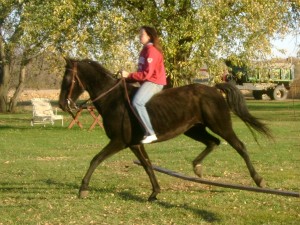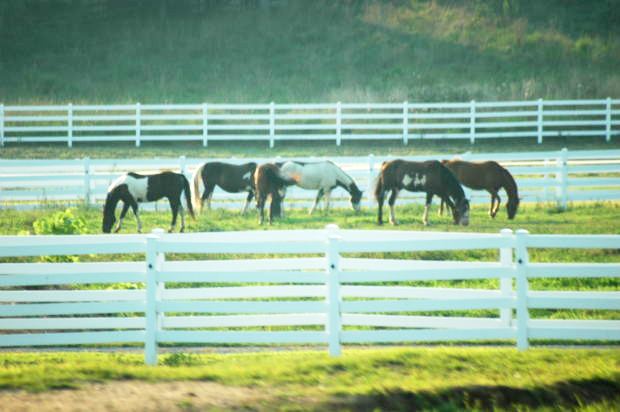 When I was sixteen, I wanted to learn to ride English. Growing up on a cattle ranch in the midwest was not condusive to getting a refined education in horseback riding. I learned the hard way—my sisters threw me up in the saddle and I did my best to stay on. But I did a lot of reading as a kid, and lived in a world of complete horse craziness, and in my Western-only world I felt there was a void.
When I was sixteen, I wanted to learn to ride English. Growing up on a cattle ranch in the midwest was not condusive to getting a refined education in horseback riding. I learned the hard way—my sisters threw me up in the saddle and I did my best to stay on. But I did a lot of reading as a kid, and lived in a world of complete horse craziness, and in my Western-only world I felt there was a void.
So I started saving my weekly allowance in hopes of buying my own English saddle. I had torn out an ad from a Western Horseman magazine where you could order a whole saddle package complete with bridle, pad, stirrups, and girth for only $99. When I had the money saved up, I took the clipping to my parents and asked if I could order it. My dad said, “No, there’s no use for an English saddle on a cattle ranch!” No amount of my “weaseling” would convince him that I needed an English saddle.
So I borrowed an English saddle from a neighbor, put on my winter boots that somewhat resembled riding boots, attached a spare throat latch around the nose of my Western bridle so it would look more English, and saddled up my ranch gelding. I don’t think that the saddle had any adverse effect on the horse, since he was used to being ridden in all sizes of saddles or bareback without fuss, but the horse had a running habit, and halfway into our ride he bolted. I remember feeling the saddle slip sideways and trying to center myself behind the withers while the saddle made its own way further down the side of the horse. The saddle pad fell off first, then me, and the horse continued on over the hill with the saddle flopping below his belly.
In hindsight, though the saddle was not to blame, it didn’t help my balance any. Thankful that my horse nor myself had been hurt, I returned the saddle to my neighbor and gave up all hopes of being an English rider. Since then, I have made a few friends online who ride English, some who jump, show dressage, or rehabilitate racehorses and train them for jumping. Their photos and comments always intrigue me, and I’m always hoping to learn more about the more proper ways of riding.
I had a woman come look at a couple of my horses last weekend. She was wanting to buy a horse for her eleven year old daughter, and thought maybe one of ours would fit the bill. “Has he ever jumped?” was one of the first questions. I told her I didn’t know, but I’d go out and try him over a few small jumps and see.
I went out and set up a few jumps. That is to say, I got some 2″ x 6″ planks and propped them up with a couple of wire tomato cages at each end. They worked just fine. I was able to trot a nice circle and come at them levelly, and my horse stepped them without any evasive behavior or trying to balk. I rode bareback, to avoid getting a Western saddle horn in the gut, and had a pretty good reminder over the next couple of days of just how long it had been since I had ridden a horse bareback! It takes a lot of muscle to sit a jumping horse bareback, and mine were definitely hurting later.
But it reminded me of my dream from long ago. I have often thought that if I lived in a city and kept a horse boarded, I would try to buy a saddle, take riding lessons and learn from a good instructor. But I’m a country girl at heart, and I find that what I grew up with is so strong in me that I will probably never change. For instance, just like piecing together my bridle to make it look English when I was a teenager, here I am at twice that age still piecing together jumps out of tomato cages and scrap wood from the garage.
If a refined way of riding ever finds its way into my life, I’ll be surprised. But I love the horse world in its entirety, and would love the chance to try English for real. Maybe someday…..


{ 1 comment }
I too preferred riding bareback when I was a teenager. It was easier on the horse, they seemed to enjoy going out to ride much more if they weren’t toting a saddle, and it was always warmer in the winter. I maintained it was a little safer, as well, because it was so easy to slide off quickly if some danger presented itself, rather than hanging on to the saddle until your horse was blown sky high in a rear or buck with you going off mid-air and coming down hard or perhaps underneath the horse….but that is debatable.
I was never able to swing up Indian-style onto a horse, but my sisters could do it easy as pie. So I was always the slow one, leading my horse ’round to a fence to climb up onto his back. I have scars under one knee from climbing up on a barbed wire fence to mount my horse. My foot slipped, the leg went over the wire and hung on a barb just beneath my knee joint. Ow! But growing up with horses, I have quite a few scars.
I agree that horses are built and minded to do a certain job and taking them out of their element can lead to all kinds of trouble. I think there is a thrill in jumping that people chase after….much like giving a teenage boy a motorcycle and expect him to putter around on safe roadways? Not likely….it is much more fun the faster and higher up you go! But not necessarily the safest for rider or horse.